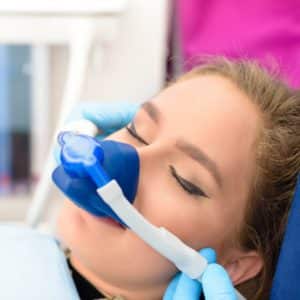
But tell that same person he or she has an appointment the next morning with Dr. Fong for a routine cleaning and exam and they want to enter the witness protection program and disappear.
What’s going on? The causes of dental anxiety are hard to put a finger on. Maybe the person watched Marathon Man as a child and the “Is it safe?” scene left a lasting impression. Maybe the sound of a dental drill is worse than anything Freddie Krueger can do. Whatever the cause of the anxiety, the anxiety can lead to a patient skipping appointments for necessary routine cleanings and exams, or for more serious issues such as gum disease. This is a real problem because most dental problems, if caught and treated early, don’t turn into big problems.
To help our patients deal with their anxiety, Dr. Fong offers sedation dentistry.
What is sedation dentistry?
Sedation dentistry involves the use of medications to keep patients relaxed during dental procedures. This is different than full general anesthesia because in sedation dentistry the patient is usually awake and is able to respond to requests from Dr. Fong. The sedation simply allows the patient to relax and overcome his or her anxiety.
What are the levels of sedation?
There are four levels of sedation:
- Minimal sedation — Under minimal sedation, you are awake but relaxed.
- Moderate sedation — This used to be called “conscious sedation.” You may slur your words when talking and not remember most of what occurred during the procedure.
- Deep sedation — In deep sedation, you are on the edge of consciousness but can still be awakened.
- General anesthesia — You’re completely unconscious.
What types of sedation are used?
- Oral sedation can be minimal to moderate. The patient takes a pill (usually Halcion, in the same drug family as Valium) usually about 30 minutes before the procedure. The pill makes the patient drowsy. Oral sedation is the most common form of sedation used in dentistry.
- Everyone knows about laughing gas, formally known as nitrous oxide. Nitrous oxide is combined with oxygen and the patient breathes it through a mask placed over the nose. The gas wears off quickly and the patient usually can drive home following the procedure.
- Intravenous sedation works more quickly as the sedative drug is delivered into the bloodstream. The method allows Dr. Fong to adjust sedation levels continually.
- Deep sedation and general anesthesia are delivered intravenously, as well. A patient under general anesthesia cannot be awakened easily until the anesthesia wears off or is reversed using a different medication.
Your comfort is our priority with Dr. Fong and our entire staff. Call us at (714) 549-1903 and ask about our sedation dentistry options.
